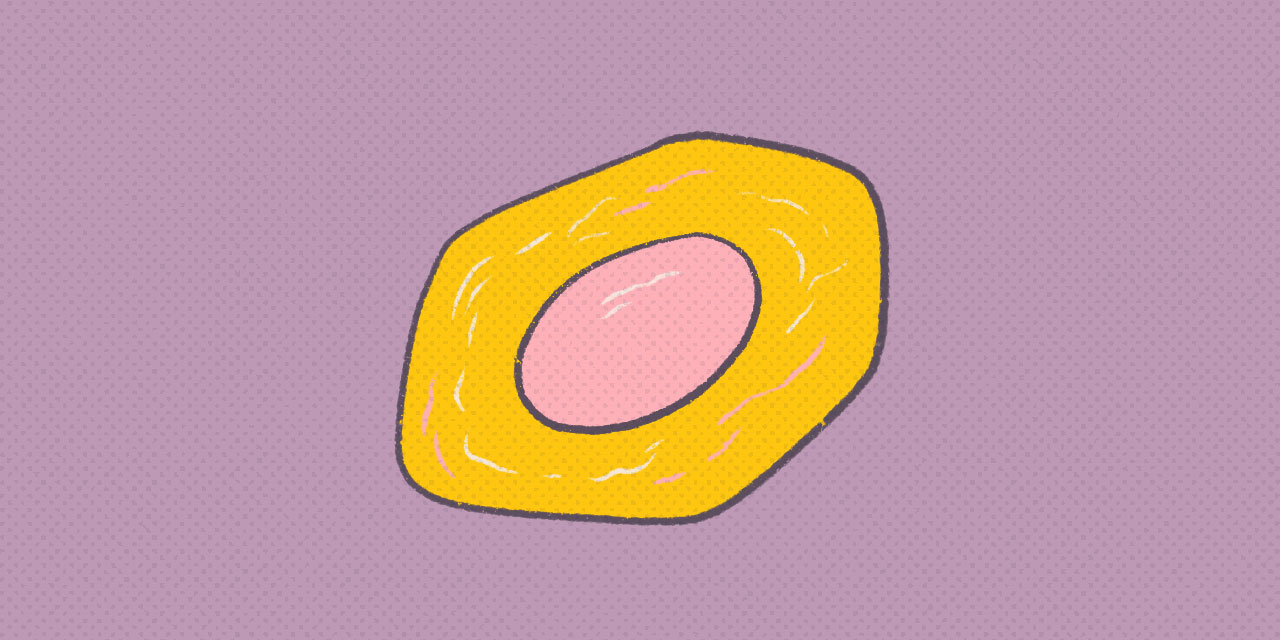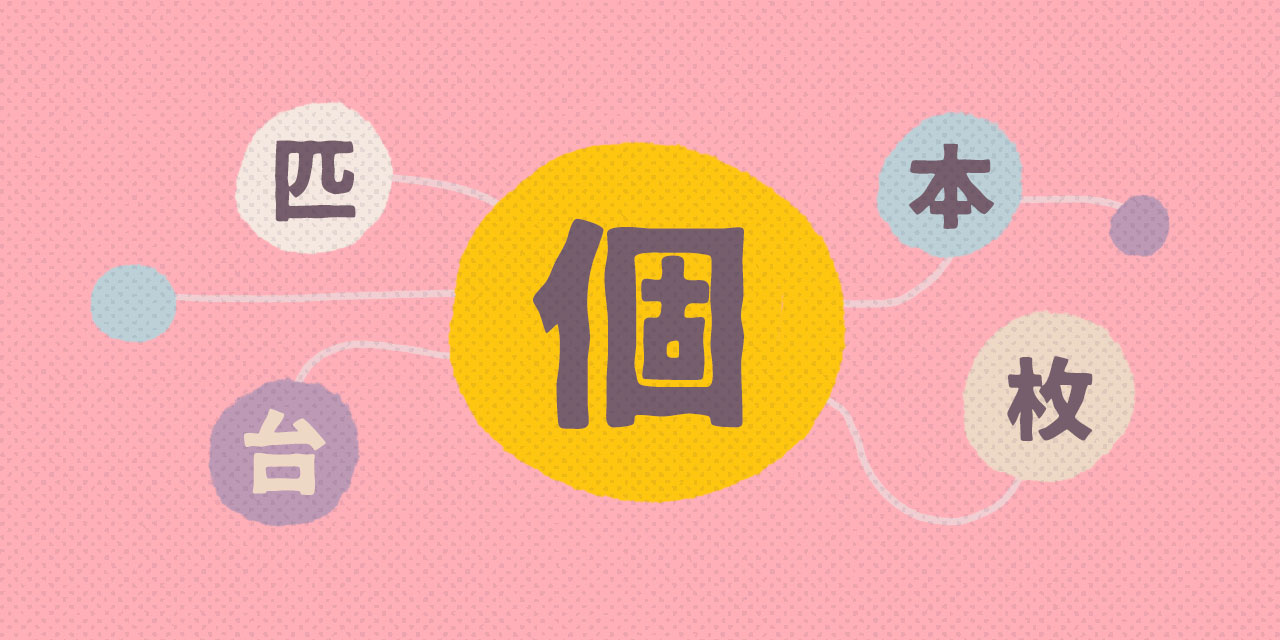The Japanese counter 個 (こ) is one of the most useful counters you will learn.
The Japanese counter 個 (こ/ko) is one of the most useful counters you will learn. It can count a huge number of things that generally have a clear boundary (though more on that in a moment). In old Japanese writings, you may come across the kanji 箇 instead of 個 to mean the same thing—these days, however, 個 is preferred.
One main point to start with: although less versatile, 個 is similar in use—and usefulness—to the 〜つ counter. You'll see quite a bit of overlap, though, and because of that we recommend you read about the 〜つ counter (if you haven't already) soon after finishing this lesson.
- Pronunciation of Japanese Counter 個
- Three-Dimensional Things
- Empty Things
- Gigantic Things
- Tiny, Tiny Things
- Things Without Definite Shapes
- Things You Can't Touch
- Substitution for the Other Counters
- Let's Wrap This Up and Go Out for Ice Cream KOnes
Prerequisite: If you're completely new to Japanese counters, we recommend you learn the basics first. Make sure you know how to read hiragana and katakana. We'll mention the "kango/wago/gairaigo counting method," and you can learn about all three of these Japanese numbering systems in our Counting in Japanese article. Knowing the kanji for numbers will help, too. In our example sentences and explanations, we equally use Arabic numerals (1, 2, 3) and Japanese kanji (一, 二, 三), since both are quite common in Japanese.
Pronunciation of Japanese Counter 個
Before taking a closer look, spend some time with the pronunciation table to learn how to count using 個.
| Numeral | Japanese | Reading 1 | |
|---|---|---|---|
| 1 | 一個 | いっこ | |
| 2 | 二個 | にこ | |
| 3 | 三個 | さんこ | |
| 4 | 四個 | よんこ | |
| 5 | 五個 | ごこ | |
| 6 | 六個 | ろっこ | |
| 7 | 七個 | ななこ (しちこ) | |
| 8 | 八個 | はちこ/はっこ | |
| 9 | 九個 | きゅうこ | |
| 10 | 十個 | じゅっこ (じっこ) | |
| 11 | 十一個 | じゅういっこ | |
| 12 | 十二個 | じゅうにこ | |
| 100 | 百個 | ひゃっこ | |
| 1,000 | 千個 | せんこ | |
| 10,000 | 一万個 | いちまんこ | |
| How many | 何個 | なんこ |
To learn about pronunciation changes when combined with numbers, you can always take a look at our Japanese Counters guide.
Three-Dimensional Things

Things that have a three-dimensional shape can be counted with 個. Although certain shapes use more specific counters, such as 枚 for flat things and 本 for long things, 個 can be substituted for most of these and still make perfect sense. And you can use 〜つ in these situations, too, depending on your preference.
- パンを二個食べた。
- I ate two servings of bread.
- コウイチはどうしてメガネを二個かけてるの?
- Why does Koichi wear two pairs of glasses?
- 三個ずつ分けよう。
- Let's split it into three pieces each.
- 帽子を四個買った。
- I bought four hats.
- この木にはハチの巣が五個ある。
- There are five beehives on this tree.
- 赤い石を一個ずつ並べた。
- I lined up red stones one by one.
Empty Things

In Japanese, containers of different shapes often have different counters: soda cans, for example, are counted using 本 (ほん), tuna cans using 缶 (かん), and cardboard boxes using 箱 (はこ). When these containers are empty, however, people will often use 個 to count them instead.
For example, if a couple of fruit crates were filled with oranges, you would count them with 箱:
- みかんを2箱送りました。
- I shipped two boxes of oranges.
Yet if the boxes were empty, you'd tend to use 個 instead:
- そこには空のダンボール箱が2個置いてあった。
- There were two empty cardboard boxes left there.
Similarly, with full cans or bottles of beer, you use 本.
- ビール六本買ってきたよ。
- I bought six bottles of beer.
But when the same containers are empty, you'd switch to 個.
- 公園で空き缶を20個拾った。
- I picked up twenty empty cans in the park.
Gigantic Things

- 一個の大きな隕石が地球に向かっている。
- A big meteorite is heading toward Earth.
個 is used for other things as well. Really really big things, such as planets or meteorites, are counted using 個. Similarly, smaller really big things, such as clouds, typhoons, and tornadoes, can also be counted using 個. When it's referred to in a more official or formal context, like a news article, 個 would be preferred over 〜つ. In speech, however, either counter works just fine.
- 一個の大きな隕石が地球に向かっている。
- A big meteorite is heading toward Earth.
- 新しい惑星が2個発見された。
- Two new planets were discovered.
- 向こうの空に、大きな雨雲が4個見える。
- I can see four giant rain clouds in the sky over there.
- 今年はハリケーンが七個も上陸した。
- This year, seven hurricanes made landfall.
Tiny, Tiny Things

On the opposite end of the spectrum, really really small things, such as cells, viruses, or bacteria, tend to be counted with 個.
- 人間の体には、約37兆個の細胞があります。
- There are about 37,000,000,000,000 cells in a human body.
- 1m2あたりに何個ぐらいの花粉が飛んでると思う?
- How many individual grains of pollen do you think are flying around in one square meter?
Things Without Definite Shapes

Even though it's known for counting things that have three-dimensional shapes, 個 can also be used for things whose shapes are not easy to distinguish—things such as shadows or stains.
- 青アザが三個も足にある。
- I got three bruises on my leg.
- 駐車場に水たまりが五個あった。
- There are five puddles in the parking lot.
This is where things get a little confusing. When you read the 〜つ article, you'll learn that 〜つ can also be used to count shadows—and, in this case, is actually the Japanese counter we'd recommend. Why? Things like shadows or puddles, whose boundaries aren't very clear, shouldn't be counted with 個; 〜つ can handle them just fine. We'll talk about this more in the next section.
Things You Can't Touch

Computer and Internet-related things… are digital but definite. You can count them using either 個 or 〜つ.
What about things that aren't "things" in the normal sense? Say, for example, you have five ideas. It's fine to count them using 〜つ (since 〜つ can count anything), but can you count them using 個? It depends. If those ideas are very clear, then you might. But if those ideas are unclear, or you're still wondering about them, it's probably best to use 〜つ instead. Vague concepts are better counted using 〜つ; clearer ones are better counted using 個.
- 今はまだ三個しかアイディアがありません。
- I still only have three ideas.
- 俺にも考えが一つあるよ。
- I have a thought.
Certain other intangibles are like this, too. For example, if you were to count the seasons, it would be more common to use 〜つ because there is a slow transition between seasons—it doesn't suddenly switch from fall to winter in one day. Is the boundary unclear? Use 〜つ. If it's not, use 個.
- この国には季節が四つある。
- There are four seasons in this country.
Sounds are another example of something with boundaries you can't really see. Sounds mix with and blend into other things and with each other. Counting a sound using 個 would be weird; use 〜つ instead.
- 今大きな音が一つ聞こえなかった?
- Didn't you hear a loud sound just now?
In the same vein, certain sports plays—clear ones, at least—can be counted with either 個 or 〜つ.
- あの選手は盗塁を三個も決めた。
- That player stole three bases.
- ひとつもヒットを打てなかった。
- I couldn't get even one hit.
Finally, computer and Internet-related things—IP and email addresses, links, files, passwords, and so on—are digital but definite. You can count them using either 個 or 〜つ.
- Eメールアドレスを三個持っています。
- I have three email addresses.
- 新しいプログラムを一つ覚えました。
- I learned a new program.
As you can see, non-physical things are something of a gray area. Yet if you just think, "Does this have a boundary?", you'll' be able to make an educated guess. In a pinch, remember that 〜つ will work either way—use it if you're not sure.
Number of Orders

For new speakers, trying to figure out whether to use 個 or 〜つ is common. And the rules are pretty arbitrary! When you place a food order, for example, you can use either 個 or 〜つ.
- ホットドッグ三個もらえますか?
- Can I get three hot dogs?
- 枝豆三個と冷奴二個ください。
- Three edamame and two cold tofu, please.
Drink orders, on the other hand, are usually given using 〜つ. (If the drink you're ordering comes in a can, however, 個 becomes okay to use.)
Are you confused yet? 🤨
- コーラ2つください。
- Two colas, please.
- オレンジジュース二個ください。
- Two orange juices, please.
What about other kinds of orders? For items that typically come as a single unit, like a hat or toothbrush, either 個 or 〜つ works fine. But for those things that come in pairs—pants, glasses, scissors, gloves, socks, earrings, skis, chopsticks—you'll want to use 〜つ.
Japanese people don't generally consider things like pants or glasses as a pair. You can count those with either counter, but be aware that using 個 may make it sound like you're talking about one of the pair (i.e., one earring rather than a pair of earrings).
- その帽子を一個ください。
- May I have one of those hats?
- この歯ブラシ、一個一万円もするの?
- Is this toothbrush ¥10,000 for one?
- このパンプス一つください。
- Can I get a pair of these pumps?
- サングラスを二個もらった。
- I was given two pairs of sunglasses.
That said, using a more specific Japanese counter for the above items is best. Toothbrushes and glasses are usually counted with 本, and shoes are counted with 足 (そく). The catalog goes on and on, which is why we made a list of common counters to learn!
Substitution for the Other Counters

The counter 個 can also be used as a substitute for other counters. Here's an example: say you didn't know that toothbrushes normally get counted with 本; you can use 個 (or 〜つ) instead, and native speakers will likely know what you mean.
- テレビを一個ネットで注文した。
- I ordered one TV online.
- レーズンが三個あります。
- There are three raisins.
Age Differences
You can also count the age difference in years between people using both 個 and 〜つ.
- 私は5個上の人と結婚しました。
- I married someone who is five years older than me.
- 三個下とは思えないぐらい大人びている。
- She is so mature, it's hard to believe she is three years younger than me.
Unlike 〜つ, however, you can't use 個 to count the actual age of someone—only the difference between two people's ages. Be careful!
Ordinal Numbers
Finally, if you're counting things that are in a certain order, you can add the ordinal number suffix 目 (め) to 個. Here are a few examples:
- 三個目の信号を左に曲がってください。
- Turn left at the third traffic light.
- 1つ目の角を右に曲がってください。
- Turn right at the first corner.
- ここから二個目の駅で降りてください。
- Get off at the second station from here.
- そこから4つ目のバス停で待ってます。
- I'll be waiting for you at the fourth bus stop from there.
Unit for Water Runoff
Although rare and specific, 個 can be used as a unit for water flow. In this case, 1個 means 1立法尺 (りっぽうしゃく)—or about 27.63 liters—per second.
- この川の流水量は現在4個です。
- The current water flow of this river is about 110 liters per second.
You'll probably never need to know this unless you work at a Japanese dam.
XX 箇 (か) + YY
The ヶ in 1ヶ月 is actually just 個!
Perhaps the most common example of using ordinal numbers for 個 is in counting months, such as 1ヶ月, which means "one month." That ヶ is actually 箇, and if you were paying attention you'll remember that 箇 is an archaic form of 個. The ヶ in 1ヶ月 is actually just 個!
- 三ヶ月で日本語がペラペラになった。
- I became fluent in Japanese in three months.
You'll come across this pattern quite a bit, in such examples as 1箇所 (one place) or 1箇国 (one country). It's common to replace the 箇 with ヶ or ヵ, so be aware that they're interchangeable.
- この車は二箇所に傷がある。
- This car got scratched in two places.
- 四カ国語が喋れます。
- I can speak four different languages.
Let's Wrap This Up and Go Out for Ice Cream KOnes
As with 〜つ, the Japanese counter 個 is flexible and can be used to count almost anything. There are some exceptions, mostly around things that don't have a clear boundary. In such cases, it's better to use 〜つ instead. Again, we highly recommend you read the article about the counter 〜つ as well, since 個 and 〜つ relate to each other in many different ways.
When you're ready for more counting action, check out some of the other in-depth Japanese counters articles we've written: 台, 本, and 枚 are good ones, in our opinion.
And if you're new to this whole counters deal, we recommend you learn the basics of Japanese counters, and then scroll through our massive study list of Japanese counters, which can take you to all the counters we've written about in-depth.
-
Cells with multiple entries divided by a
/indicate multiple pronunciations that are equally common. Cells with entries in parentheses indicate that the parenthesized word is an uncommon or archaic pronunciation. ↩
